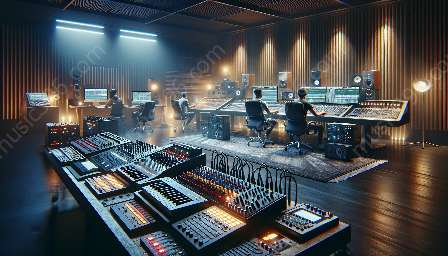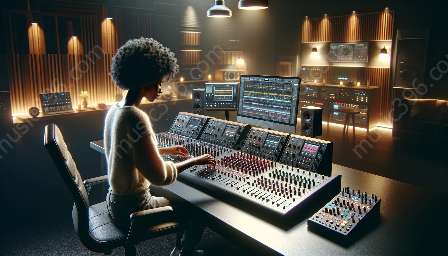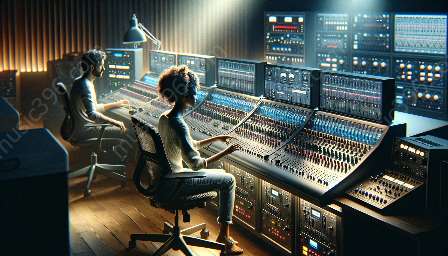Music production is a fascinating blend of science and art. It involves the application of various technical and creative elements to create a musical composition that captivates and engages listeners. One crucial aspect that significantly influences music production is psychoacoustics. By understanding how psychoacoustic principles impact music creation, artists and producers can enhance the quality and appeal of their work.
What Is Psychoacoustics?
Psychoacoustics is the branch of psychology and acoustics that deals with the perception of sound, particularly in relation to music and speech. It delves into how humans perceive and interpret various auditory stimuli, including pitch, loudness, timbre, and spatial location.
Understanding psychoacoustics is essential for music producers, as it provides insights into how listeners perceive and respond to music. By leveraging psychoacoustic principles, producers can create compositions that resonate with audiences on a deeper level.
Psychoacoustic Principles in Music Production
Psychoacoustic principles play a crucial role in shaping music production in several ways:
- Frequency Masking: This principle refers to the phenomenon where the perception of one sound can be affected by the presence of another sound at a similar frequency. In music production, understanding frequency masking is vital for ensuring that different elements of a mix remain audible and distinct. Producers often employ techniques such as frequency-specific dynamic processing and EQ adjustments to mitigate masking effects and enhance clarity.
- Harmonic Series and Timbre: The harmonic series, which dictates the arrangement of overtones in musical sounds, directly influences the timbre of instruments and voices. By applying psychoacoustic knowledge of the harmonic series, producers can manipulate the tonal qualities of instruments to achieve specific timbral effects. This understanding is integral to shaping the overall sonic character of a musical piece.
- Spatial Audio Perception: Psychoacoustics also governs how humans perceive the spatial attributes of sound. Music technology leverages spatial audio processing and binaural recording techniques to create immersive listening experiences. Understanding spatial audio perception enables producers to craft mixes that convey a sense of depth, width, and dimensionality, enhancing the spatial realism of the music.
- Loudness Perception and Dynamic Range Compression: The human ear does not perceive all frequencies and volumes equally. Psychoacoustic research has revealed insights into how individuals perceive loudness, leading to the development of dynamic range compression techniques in music production. Producers use compression to manage the dynamic range of audio signals, ensuring consistent perceived loudness and optimizing the overall balance of a mix.
- Pitch and Melodic Perception: Psychoacoustic studies have deepened our understanding of how pitch and melody are perceived by the human auditory system. Music technology harnesses this knowledge to address pitch-related challenges, such as pitch correction and harmonization. By aligning with psychoacoustic principles, producers can refine melodic elements and correct pitch inaccuracies to enhance the musicality of a composition.
Implications for Music Technology
The influence of psychoacoustic principles extends beyond the creative process to the realm of music technology. Innovations in music production tools and equipment are often guided by psychoacoustic research, leading to the development of advanced technologies that align with human auditory perception.
Digital Signal Processing (DSP) and Equalization:
Psychoacoustic insights have shaped the evolution of DSP algorithms and EQ techniques. The development of perceptual coding schemes, such as MP3 and AAC, is a testament to how psychoacoustic principles have revolutionized digital audio compression. With a focus on masking thresholds and audio perception models, music technology has advanced to deliver high-quality audio compression while minimizing data redundancy.
3D Audio and Immersive Sound:
Pioneered by the principles of psychoacoustics, 3D audio technologies aim to replicate spatial audio perception in a virtual environment. Binaural recording, ambisonics, and object-based audio formats are revolutionizing the way music is produced and consumed, offering listeners immersive and lifelike auditory experiences. The integration of psychoacoustic principles has driven the development of virtual and augmented reality (VR/AR) audio solutions, expanding the possibilities for immersive music production.
Psychoacoustic Modeling in Instrument Design:
Instrument manufacturers and digital instrument designers leverage psychoacoustic modeling to simulate and recreate the sounds of acoustic instruments. By understanding how humans perceive instrumental timbres, technology has advanced to produce virtual instruments that closely emulate the characteristics and nuances of traditional acoustic counterparts. This integration of psychoacoustic principles in instrument design has diversified the sonic palette available to music producers.
Enhancing the Creative Process
For musicians and producers, an in-depth understanding of psychoacoustic principles can enrich the creative process. By integrating psychoacoustic knowledge into their workflow, creators can craft more engaging and impactful musical experiences. Here's how psychoacoustics enhances the creative process:
Intuitive Sound Design:
Psychoacoustic principles inform sound designers and synthesists about the perceptual attributes of sound. This knowledge allows for intuitive sound design, where the sonic characteristics of a patch or sound effect can be tailored to align with human auditory perception. By considering psychoacoustic principles, sound designers can create sounds that resonate with listeners and evoke specific emotional responses.
Optimized Mix Translation:
Understanding how the human auditory system perceives various sonic elements is pivotal in achieving accurate mix translation across different playback systems. Producers who are cognizant of psychoacoustic principles can create mixes that maintain their sonic integrity and impact regardless of the playback environment, ensuring consistent sonic experiences for listeners across diverse listening setups.
Dynamic Range Management:
Psychoacoustic insights play a significant role in dynamic range management during music production. Producers utilize multiband compression and limiter techniques to align with the nonlinear perception of loudness in humans, resulting in mixes that maintain balance and impact across varying volume levels while preserving the artistic dynamics of the music.
Conclusion
Psychoacoustic principles wield a profound influence on music production, shaping the way music is created, perceived, and experienced. By embracing the insights provided by psychoacoustics, music producers and technologists can unlock new creative possibilities and elevate the quality of musical compositions. This integration of scientific understanding and artistic expression underscores the dynamic synergy between psychoacoustics and music technology, paving the way for future innovations and heightened sonic experiences in the realm of music production.

























